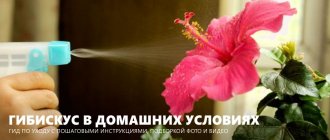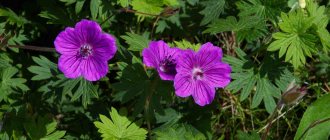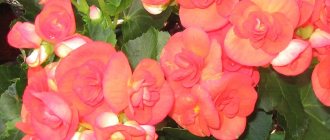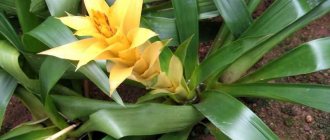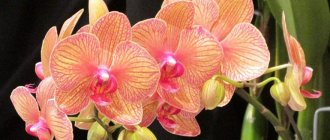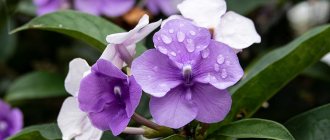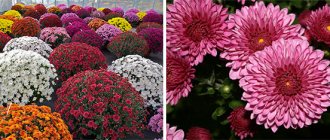Calathea Varshevich attracts flower growers with its unusual appearance. This luxurious plant can decorate any apartment or office space.
The leaves of the crop are unusual dark green in color with a light green pattern on the surface . When darkness comes, the plant lifts its leaves and closes for the night.
Maranta calathea Varshevich description and characteristics
Calathea is a perennial crop with a short stem. The leaves are large, long-petiolate, collected in a rosette, located in the lower part of the shoot . Depending on the growing conditions, the leaf length ranges from 15 to 50 centimeters. The plates are simple, oval in shape with a wavy velvety surface.
A clear pattern is visible at the top of the sheet. Thick light stripes with jagged edges are well defined against the overall dark green background. The attractive design resembles a Christmas tree. The inner surface of the leaves has a beautiful brown-burgundy color. The petioles have the same color.
The culture is valued by gardeners not only for its attractive decorative foliage. Another feature of this plant is long-lasting flowering . The perennial inflorescences are large, cream or white in color, in the form of a spike. Flowers are formed on small peduncles. Flowering lasts from mid-May to July.
Note! The main feature of Calathea Varshevich is the ability to lift and fold leaves in the evening.
Types of calathea with photos and names
There are 130 known plant species created by nature, but breeders have created many more hybrids. The leaves of the plant not only delight the eye with their colors, but they are still used for weaving baskets, they wrap fresh fish in them to preserve them for a long time, and even make hats and bags from them.
More often, flower growers can buy plant varieties in the store, both natural and hybrids bred by breeders.
Kalathea Varshevich
Plant height is from 30 cm to up to a meter. It has dark green leaves, purple underneath, with petioles that are velvety to the touch. Along the central vein of the leaf there are patterns of spots and stripes of light colors. The flowers have dim colors - white, cream, pink. It blooms from late spring, lasting up to three weeks.
Calathea saffron
This type of plant has another name - Calathea Crocata. It has “false” flowers, more beautiful than the real ones, which are small in size and inconspicuous in appearance, pink or red in color and collected in large saffron-colored bracts. The leaves are 20-30 cm long, dark green in color and have a velvety surface. It blooms either in early spring or late autumn.
Calathea lancifolia (lanceolate)
The leaves have the shape of an elongated lancet and an unusual color: shades of dark burgundy below, and bright green at the top with juicy dark green transverse veins. They have a beautiful accordion shape and are slightly bent inward along the middle vein.
Calathea Rufibarba
Otherwise called Redbeard. Reaches a height of up to 70 cm. The leaves are located on long petioles and have an elongated and pointed shape. The leaves are volumetrically corrugated, have a herringbone pattern and waves on the edges. The petioles and bottom of the leaves are red in color.
Calathea zebrina care at home
Home care
The natural habitat of the plant in question is the central states of the United States, as well as the territory of Panama. Caring for Calathea Varshevich has its own characteristics ; the florist must become familiar with the nuances of the procedures.
Temperature
When growing calathea, it is necessary to create a special regime. The plant does not like sudden changes in temperature; the ideal parameters for its development are considered to be a range from 19 to 24 degrees. Changes during the day and night hours are especially dangerous for the flower.
It is not recommended to take the culture out onto the balcony or place it on a cold windowsill; it also does not like ventilation in winter. The temperature of the soil in the pot should be between 19-21 degrees.
Important! Overheating or cooling can cause disease or death of the flower.
Air humidity
Calathea is a tropical plant that thrives in high humidity. In such conditions, the crop quickly grows green mass and forms large leaves .
When grown at home, a flower can adapt to dry air , but the rate of its development will slow down, it will hurt, and the inflorescences will become small. This is how plants respond to low humidity.
Advice! To create favorable conditions, calathea is sprayed several times a day using a spray bottle. To obtain additional moisture, place a tray of water near the flower pot. Laying moss on the top of the nutrient substrate will help prevent evaporation.
Lighting
The culture prefers bright light, but can die from prolonged exposure to direct sunlight. With this influence, brown spots appear on the surface of the leaves , which grow over time. This leads to wilting and drying out of the vegetative mass.
When installing the plant in a shaded part of the room, the leaves lose their decorative effect. To prevent this from happening, it is necessary to observe optimal daylight hours, 15-17 hours a day . In winter, Calathea Varshevich is illuminated using phytolamps.
Conditions for successful growing at home
When grown at home, calathea requires close attention and quality care. Under natural conditions, it grows on the banks of lakes, rivers and reservoirs, so it prefers similar conditions in the apartment.
Location and lighting
For a tropical beauty, it is recommended to choose a well-lit place, but protect it from exposure to direct rays of the sun, which can lead to burns of foliage. The plant tolerates partial shade well, but you should not place it in a too dark corner of the apartment, as it can lose the beautiful color of the leaves. An excellent location for a flower pot would be the window sills in the northern part of the apartment. You can also install the container on the west or south side, while providing the perennial with partial shade.
Temperature
Calathea is a heat-loving crop, and even in winter it requires maintaining a stable air temperature of at least +16°C. The flower reacts negatively to sudden temperature changes, which can provoke wilting of the leaves and loss of elasticity of the petioles. Cold drafts are considered detrimental to the plant.
Air humidity
The flower prefers to live in conditions of high humidity, the optimal level of which is 85–90%. It is quite difficult to achieve such indicators in an apartment or private house, so many gardeners grow the plant in aquariums and special florariums. It is recommended to spray calathea regularly.
Important! In the case of calathea, a lack of sunlight will cause less harm than low humidity and too dry indoor air.
Moreover, the area near the flower should be moistened more, and not the plant itself. If drops of moisture linger on the leaves, they can lead to the appearance of dark spots. A moist environment for calathea can also be created in a tray: cover the bottom of the container with damp moss or pebbles, fill it with water and place the pot so that the bottom of the pot is located on the “litter” and is not immersed in water.
Watering
A resident of the tropics needs abundant watering with warm water at room temperature. You need to be careful when moistening the soil ; excess moisture in the nutrient substrate can cause rotting of the plant's root system.
Wait until the top layer of soil dries, use rain or settled water for irrigation.
Landing
Neutral soil with acidity in the range of 5-7 pH is suitable for planting the plant. The nutrient substrate must be loose and breathable. For calathea, purchased soil for Saintpaulia is suitable . But you can prepare the soil yourself. The following components are used for this:
- 1 part peat;
- 1 part deciduous soil;
- 1 part humus;
- 0.5 parts sand.
All components are thoroughly mixed , after which a small amount of charcoal and pine bark are added. These substances improve soil aeration.
Before planting the plant, drainage made of small pebbles or pieces of broken brick is placed at the bottom of the pot. The thickness of the drainage layer is 3-4 centimeters . The plant is planted in a new nutrient substrate and watered.
Transfer
It is recommended to transplant Calathea Varshevich in the spring. To prevent damage to the root system, the method of transferring it into a larger container is used . The culture develops well in shallow but wide flowerpots made of ceramics or other material other than plastic.
The procedure for transplanting calathea occurs according to the following algorithm;
- pour drainage into the flowerpot;
- we move the plant into the pot along with a lump of earth ;
- we fill the voids with a new nutrient substrate;
- We water the plants with settled water at room temperature.
After completing all the procedures, place the pot with the flower in a warm place and wait for it to take root.
Feeding
In its natural habitat, the plant feeds on animal and bird excrement dissolved in water. The roots of this culture absorb useful substances that were formed as a result of rotting leaves, from the remains of dead insects and other products.
When growing calathea at home, it is recommended to use complex mineral fertilizers consisting of equal proportions of potassium, phosphorus and nitrogen. Such solutions are often used, but the dose of nutrients is reduced to 25% of the required norm.
Features of cultivation
The main feature of calatheas is their unusual leaves, but there are other properties and distinctive features that you need to know about if you are going to care for your homemade calathea. In most plant species, underground shoots form a superficial root system, from which rosettes of large oval leaves up to 30-40 cm long grow on long petioles. The height of a calathea flower can reach 70-90 cm. The flowering of calathea is unattractive, with the only exceptions being calathea saffron and calathea Varshevich, whose inconspicuous flowers are hidden behind bright bract leaves of cream, white, orange and pink shades.
The home flower Calathea is very demanding to care for, but there are species that are more adapted to indoor growing conditions and those that are less adapted. The first include Calathea Bachema, as well as decorated, Makoya, striped, Veicha (Vicha) and some others.
Kalati have one feature common to all arrowroots: in the evenings, the leaves of the plant fold and rise upward, like palms during prayer, and in the morning the leaves lower and open. For this reason, calathea, like arrowroot, is called the “prayer flower.”
Reproduction of calathea at home
In practice, several methods of culture propagation are used. Let's take a closer look at them.
Dividing the bush
The plant in question must be updated at least once every 4 years. During transplantation, the crop is divided into several parts , and each division should have three or four developed shoots left. These plants are transplanted into a new container and rooted in moist soil.
Leaf and cuttings
For this operation, the stems that remain after the formation of the crown are used. When propagating by cuttings, take segments 9-12 centimeters long . Each shoot has 3-5 internodes. The leaves are torn off at the bottom node; it will be used to root the plant.
Important! The cuttings are placed in a jar of water or a moist nutrient substrate made from a mixture of sand and peat. The containers are transferred to a warm room with a temperature of 20-24 degrees. A plastic bag is placed over the seedlings, which will promote better rooting.
The seedlings are ventilated once a day and watered. After 2 weeks, young plants should form roots. When the crops begin to grow, they are transplanted into separate containers. The principles of propagation of Calathea Varshevich by leaf and cuttings are similar.
This video shows how you can propagate arrowroot by cuttings and beautifully form an old plant.
Growing from seeds
This method of propagation is used quite rarely due to the low germination of seed material. For sowing, only fresh grains are used , which are sown in special containers filled with a moistened mixture of leaf soil and sand in equal proportions.
The containers are covered with a transparent film and placed in a room with a temperature of 22-25 degrees for germination. After the first shoots appear, the shelter is removed. When two true leaves appear on the crops, they are transplanted into separate pots.
The main problems when growing a flower
Flower growers have long noticed that if you do not follow the recommendations for growing this capricious plant, you can encounter many problems. Most often, the leaves of the flower begin to dry out and curl up. Reasons for this condition:
- too dry room;
- the room temperature is low;
- presence of drafts.
The cause of flower diseases must be eliminated in advance, then the plant will be grateful to you, returning its former beauty.
Calathea turns yellow
When the lower leaves begin to lose color, this is natural: some leaves die, others are born. When the leaves turn yellow throughout the plant, you need to sound the alarm. The reason may be:
- improper watering,
- high concentration of fertilizers,
- cold in the room.
Calathea leaves curl when the air in the room is too dry or cool.
Pests and diseases
Damaged calathea leaves can become infected with sooty fungus, which is a black film. It does not harm the plant, but prevents it from breathing freely. You can remove the fungus with a simple soap solution.
Among the flower pests we can note:
- scale insect,
- spider mite,
- thrips.
First, you can try to fight them with a soap solution. If this method does not help, then the flower needs to be treated with insecticides. Insecticides are used to kill spider mites.
Watch the video! Calathea. Home care
Diseases and pests
Most often, problems with the plant appear due to the fault of the grower; they are associated with improper care of the crop. Yellowing of the leaves or the appearance of brown spots on the blades indicates waterlogging of the soil. In this case, it is necessary to replant the flower and temporarily stop watering.
Drying leaf tips indicate dry air around the calathea. To combat this problem, periodically spray the crop and place a container of water next to it . Brown spots on the leaves occur due to a lack of sunlight; the plant must be moved to a well-lit windowsill.
Calathea lancifolia
The type of calathea presented in the photo belongs to the few flowering varieties of the plant, but very valued by gardeners. At home, in the tropics of Brazil, Calathea lancifolia lives in conditions of almost constant temperatures, high humidity and an abundance of food. A lover of indoor plants will have to maintain the same atmosphere in order to admire the calathea flowers shown in the photo.
Calathea lancifolia is a large houseplant, the height of which can reach 80 cm. The flowers are located on short peduncles located at the base of the leaf rosette. The color of the corollas is white or slightly pinkish. The leaves are elongated, thin, light green in color with dark spots located along the central vein. On the back side, the leaf plates of Calathea lancifolia species have a reddish-violet color.
Calathea roseopicta
Calathea roseopicta comes from Brazil, where the plants reach 80 cm in height and delight the eye with variegated foliage, the like of which is difficult to find even in other types of calathea.
Calathea Medallion is most often found in the collections of indoor plant lovers. This variety can be recognized by its round-oval leathery leaves with multi-colored patterns. The central vein is pink, with olive strokes visible around it, and closer to the edge of the leaf blade there is a figured stripe of creamy or white color. The back side of the leaves of this calathea flower, located on pancake petioles, is crimson and very bright.

